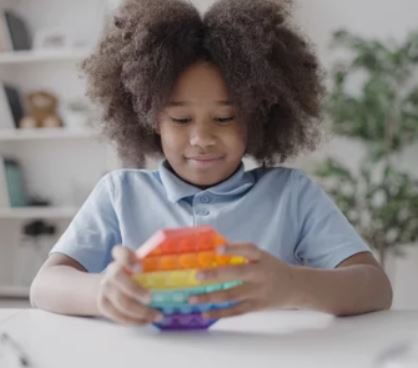Adapting Awareness/Acceptance of the Autistic Community with Micro-Accommodations
By Cheyanne Conner, AJ White and Adam Hazlett
Adapting Awareness/Acceptance of the Autistic Community with Micro-Accommodations
Sixteen years ago the first Autism Awareness Day (later changed to Autism Acceptance Day) was the beginning of countless modern campaigns to start a conversation about our understanding of autism and unfortunately how we should fix it. That stops today.
Awareness of the Autism Diagnosis Begins with a Shameful Past
The history of awareness of the diagnosis is riddled with healthcare industry misunderstandings and cruelty from medical professionals and the general public.
In December 2007, an unanimous vote by the United Nations General Assembly declared 2 April as World Autism Awareness Day. In a press release the following year the UN announced, “On this day, the United Nations reaffirms its commitment to the rights and well-being of people with disabilities -- a commitment rooted in our fundamental principle of universal human rights for all.” (1)
While it would appear advocacy for the autistic community was on the right trajectory, the day would initially be used to promote awareness campaigns while garnishing funds for autism research and sadly for many “advocacy” organizations garnishing funds for finding a cure.
It has only been within the last decade that prominent autism advocacy organizations removed “finding a cure” from their core goals and mission statements. (2)
How We Got a Puzzle Piece to Represent the Autistic Community
Early symbolism for autism awareness started with the puzzle piece that displayed a crying child created by the National Autistic Society in 1963. This fueled the initial foundation of society’s understanding that autistic people were never going to fit in and that to be autistic or have an autistic child was a tragedy. (3)
Despite this horrific origin, prominent autism advocacy organizations still use a puzzle piece in their branding and advocacy today. This further pushes the narrative that autistic people will never fit in or at best that it is difficult for them to fit in without behavior therapies.
It should be noted that some autistic individuals do not find controversy in the puzzle piece symbol that no longer includes the crying child. While celebrating uniqueness with an individual puzzle piece that is included and essential to complete a puzzle sounds like a nice sentiment, most will view it as a puzzle piece that doesn’t even belong in the box due to its originating concept.
While reclaiming the puzzle piece may be part of some individual journeys, for the autistic community at large another symbol offers a better path to empowerment.
How the Infinity Symbol Better Represents the Autistic Community
Members of the neurodivergent community started using the infinity symbol in the early 2000s. (4)
While the infinity symbol is not unanimously accepted by the autistic community it is the symbol that is most widely accepted in the community. The symbol is most often seen as either a rainbow infinity symbol to celebrate neurodiversity as a whole or a gold infinity symbol to specifically represent autism.
As the representative symbol of being autistic and neurodivergent that came directly out of the neurodivergent community, the infinity symbol aligns with self-advocacy and therefore is clearly the most fitting symbol to promote.
A representative symbol isn’t the only thing that changed for the autistic community over the last few decades.
The History of “Treatment” of Autism
In the 1960s Autism was seen as “childhood schizophrenia” as a result of cold parenting: a parenting style where the parents of a child are rather indifferent to them and take little interest in their activities. (5)
This tragic medical misunderstanding led to the autistic community facing abusive treatments for decades.
In this decade early versions of Applied Behavior Analysis Therapy were developed by O. Ivar Lovaas, who co-authored a paper supporting conversion therapy the following decade. (6) To say that this individual did not have the best interests of the autistic community in mind would be a gross understatement.
Lovaas’ viewpoint of autistic people was that they were barely human and stated “you have a person in the physical sense—they have hair, a nose, and a mouth—but they are not people in the psychological sense.” (7)
With this in mind many ABA or other therapies for autistic people that model this early mentality should be avoided by the autistic community and by any caregivers to the autistic community due to the potential harm that they could cause.
Tools and resources are desperately needed for the autistic community to make navigating the world more accommodating, but again anything that is attempting to mold individuals to be more palatable to the allistic (non autistic) community is dehumanizing.
Older Generations of Autistic People Help Advocate for the Next Generation
With ABA therapy being the answer to autism in the 70s, 80s, 90s, and early 2000s, multiple generations experience misguided “treatment” as autistic individuals. Most recently self proclaimed ABA survivors from the gen-x, millennial, and gen-z generations have collectively started changing the way “treatment” for autism is seen. (8)
Autistic children from these generations grew up and finally could start self-advocating and advocate for the generation after them. Autistic children from these generations even started having their own autistic children and directly started breaking generational trauma by offering their own children the micro-accommodations they desperately needed in their own youth.
All ages of the autistic community and allies have become a voice to end the unnecessary cruel treatment to the autistic community and represent the diverse identity that is autism.
“New ABA Therapy” or “Reformed ABA Therapy” are unofficial terms sometimes used to describe programs for autistic children that still have ABA Therapy as their billing code but don’t align with the original concepts. Since ABA is classified as “medically necessary,” resources by another name will not likely be covered without additional reform to the healthcare system. (9) Regardless of label, any program that is designed to help the autistic community needs to be highly vetted.
It should be noted as well that there is a lot of money in ABA therapy which drives the United States medical industry to push for it. So much so that the Department of Defense conducted the largest study on ABA effectiveness in 2020 to justify billions of dollars spent on the therapy for military families. Results concluded “ABA services are not working.” (10)
What Perspective Still Needs to Change
Dr. Ludmila Praslova points out neurodiversity is often explained from one of two perspectives: the deficit perspective and the diversity perspective. Medical texts associate traits of neurodiverse diagnoses with inabilities to perform to the “normal” standards and label individuals with deficits. (11)
Shifting the focus from deficit to diversity is necessary for the safety of the autistic community. A drive to understand and celebrate the vast uniqueness that everyone on the spectrum possesses is the perspective that people should have about autism.
Removing deficit from the dialogue is not meant to discredit what is disabling for the autistic community.
Autism is a disability and too often society thinks in deficit terms about disabilities because of how disabled people are seen and valued.
A better understanding of the difficulties that come with autism and other disabilities will lead to better accommodations for the whole disabled community. No longer can a diagnosis (formal or self) be a reason to view an individual as a less viable member of society.
Deconstruction of cliché representations in media and antiquated medical findings is necessary for people's perspectives to change. By embracing the drive to understand, awareness and acceptance of the autistic community becomes predestined. It’s time for the next step.
How We Take Awareness/Acceptance to Empowerment
In the early days of “autism awareness” the thought of having an autistic child was viewed as a tragedy or crisis. The actual tragedy is that for too long the narrative around “advocacy for autistic people” was to find a cure or at the very least force them to change for the convenience of others. That narrative stops now.
You cannot cure autism (nor should you ever want to) and attempts to “force it out” of someone is fundamentally abuse.
While the narrative has changed from awareness to acceptance, this cannot be the ending chapter.
The formally diagnosed autistic community makes up nearly 3% in the United States with the prevalence increasing annually as the evaluation process uses more ample criteria and becomes more accessible. Countless members of the autistic community have yet to be diagnosed, have been misdiagnosed, and self-diagnosed bringing that percentage up even more. (12)
Being aware of the community and accepting the community as human is not good enough. It’s time to include autistic people at the table. Micro-accommodations (13) from society accomplishes that. Working towards a world with universal design in mind allows for the autistic community to be included in society.
Forget Autism Awareness/Acceptance Month, it’s time to make the goal Autism Empowerment Month.
References
(1) UNITED NATIONS MARKS FIRST WORLD AUTISM AWARENESS DAY TODAY | Meetings Coverage and Press Releases https://press.un.org/en/2008/note6138.doc.htm Published online April 2, 2008.
(2) Why Autism Speaks Dropped The Word 'Cure' From Its Mission Statement https://www.huffingtonpost.co.uk/entry/cure-for-autism_n_58062f2be4b0dd54ce3522b1 Published online October 10, 2016.
(3) The Autism Puzzle Piece: A Symbol That’s Going To Stay Or Go? https://the-art-of-autism.com/the-autism-puzzle-piece-a-symbol-of-what/ Published online April 20, 2019.
(4) The Autism Puzzle Piece: A Symbol That’s Going To Stay Or Go? https://the-art-of-autism.com/the-autism-puzzle-piece-a-symbol-of-what/ Published online April 20, 2019.
(5)The evolution of ‘autism’ as a diagnosis, explained https://www.spectrumnews.org/news/evolution-autism-diagnosis-explained/ Published Online May 9, 2018.
(6) Treating autism as a problem: The connection between Gay Conversion Therapy and ABA https://nsadvocate.org/2018/07/11/treating-autism-as-a-problem-the-connection-between-gay-conversion-therapy-and-aba/ Published online July 11, 2018.
(7) Treating autism as a problem: The connection between Gay Conversion Therapy and ABA https://nsadvocate.org/2018/07/11/treating-autism-as-a-problem-the-connection-between-gay-conversion-therapy-and-aba/ Published online July 11, 2018.
(8) AMERICAN MEDICAL ASSOCIATION REMOVING SUPPORT FOR ABA?: UNPACKING DRAFT RESOLUTION 706 https://www.neurosparkhealth.com/blog/american-medical-association-removing-support-for-aba-unpacking-draft-resolution-706.html
(9) Successfully navigate ABA insurance laws https://www.coronishealth.com/blog/successfully-navigate-aba-insurance-laws/ Published online October 1, 2019.
(10) AMERICAN MEDICAL ASSOCIATION HOUSE OF DELEGATES Resolution: 706 https://www.ama-assn.org/system/files/a23-706.pdf Received: 4/3/23
(11) Your “Autism Awareness Day” Might Be Excluding Autistic People https://hbr.org/2022/04/your-autism-awareness-day-might-be-excluding-autistic-people Published Online April 01, 2022
(12) Autism Identity and the “Lost Generation”: Structural Validation of the Autism Spectrum Identity Scale and Comparison of Diagnosed and Self-Diagnosed Adults on the Autism Spectrum https://www.ncbi.nlm.nih.gov/pmc/articles/PMC8415774/ Published online March 11, 2020






